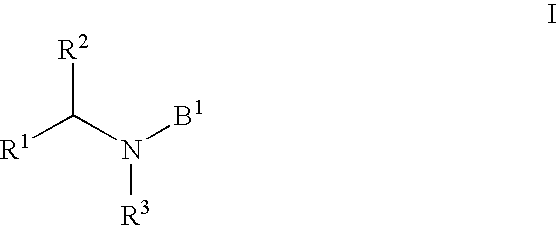HIV integrase inhibitors
a technology of integrase inhibitors and hives, which is applied in the direction of biocide, heterocyclic compound active ingredients, group 5/15 element organic compounds, etc., can solve the problems of large number of patients who fail this therapy, no clinically approved compound has resulted, and not all patients are responsiv
- Summary
- Abstract
- Description
- Claims
- Application Information
AI Technical Summary
Benefits of technology
Problems solved by technology
Method used
Image
Examples
example 1
[0166] Compound 1-A: 4-Fluoro-N-methyl-benzamide 30
[0167] To a solution of 30 mL MeNH.sub.2 (40% wt in H.sub.2O) was added 139 mL of 1N NaOH. To this was added 130 mL of CH.sub.2Cl.sub.2 followed by 4-fluorobenzoyl chloride (22 grams, 139 mmol) while the mixture was rapidly stirred. After 1 hour the organic layer was separated, washed with H.sub.2O, dried over Na.sub.2SO.sub.4 and solvent removed under vacuum to yield 20 grams (94% yield) solid. .sup.1H NMR (500 MHz, DMSO) .delta.: 2.78 (d, 3, J=5), 7.28 (t, 2, J=9), 7.91 (m, 2), 8.46 (br s, 1). .sup.13C NMR (125 MHz, DMSO) .delta.: 26.13, 114.95, 115.13, 129.49, 129.56, 130.87, 130.90, 162.67, 164.64, 165.46.
[0168] Compound 1-B: (4-Fluoro-benzyl)-methyl-amine; Hydrochloride 31
[0169] 4-Fluoro-N-methyl-benzamide (18.8 grams, 123 mmol) was dissolved in 180 mL of THF. To this was added BF.sub.3.Et.sub.2O (5.51 mL, 43 mmol) and the resulting mixture heated to reflux for 15 min. The solution was then cooled to .about.20.degree. C. and BH...
example 2
[0176] Compound 2: 1-[2(4-Chloro-phenyl)-ethyl]-4-hydroxy-5-oxo-2,5-dihydr-o-1H-pyrrole-3-carboxylic Acid (4-fluoro-benzyl)-methyl Amide 35
[0177] 3-[(4-Fluoro-benzyl)-methyl-carbamoyl]-2-hydroxy-acrylic acid methyl ester (Compound 1-D) was treated with paraformaldehyde and 2-(4-chloro-phenyl)-ethylamine as described in the preparation of Compound 1. HRMS (M-H) calcd for C.sub.21H.sub.19ClFN.sub.2O.sub.3: 401.1068; found: 401.1080. .sup.1H NMR (500 MHz, CDCl.sub.3) .delta.: 2.90 (t, 2, J=7), 2.95 (s, 3), 3.72 (t, 2, J=7), 3.95 (s, 2), 4.57 (s, 2), 7.03-7.26 (overlapping m, 8). .sup.13C NMR (125 MHz, CDCl.sub.3) .delta.: 33.92, 34.45, 44.42, 49.37, 51.46, 108.49, 115.73, 115.91, 128.87, 129.22, 129.98, 131.99, 132.67, 136.60, 154.21, 161.42, 163.37. 164.51, 166.31.
example 3
[0178] Compound 3: 1-[2(Chloro-phenyl)-ethyl]-4-hydroxy-5-oxo-2,5-dihydro--1H-pyrrole-3-carboxylic Acid (4-fluoro-benzyl)-methyl Amide 36
[0179] 3-[(4-Fluoro-benzyl)-methyl-carbamoyl]-2-hydroxy-acrylic acid methyl ester (Compound 1-D) was treated with paraformaldehyde and 2-(2-chloro-phenyl)-ethylamine as described in the preparation of Compound 1. HRMS (M+H) calcd for C.sub.21H.sub.21ClFN.sub.2O.sub.3: 403.1225; found: 403.1237. .sup.1H NMR (500 MHz, CDCl.sub.3) .delta.: 2.96 (s, 3), 3.05 (t, 2, J=7), 3.75 (t, 2, J=7), 3.99 (s, 2), 4.58 (s, 2), 7.01-7.34 (overlapping m, 8). .sup.13C NMR (125 MHz, CDCl.sub.3) .delta.: 32.37, 34.52, 42.90, 49.36, 51.47, 109.38, 115.66, 115.83, 127.18, 128.37, 129.26, 129.32, 129.67, 130.92, 132.13, 132.15, 134.01, 135.79, 152.71, 161.37, 163.33, 164.91, 166.11.
PUM
| Property | Measurement | Unit |
|---|---|---|
| Composition | aaaaa | aaaaa |
Abstract
Description
Claims
Application Information
 Login to View More
Login to View More - R&D
- Intellectual Property
- Life Sciences
- Materials
- Tech Scout
- Unparalleled Data Quality
- Higher Quality Content
- 60% Fewer Hallucinations
Browse by: Latest US Patents, China's latest patents, Technical Efficacy Thesaurus, Application Domain, Technology Topic, Popular Technical Reports.
© 2025 PatSnap. All rights reserved.Legal|Privacy policy|Modern Slavery Act Transparency Statement|Sitemap|About US| Contact US: help@patsnap.com



